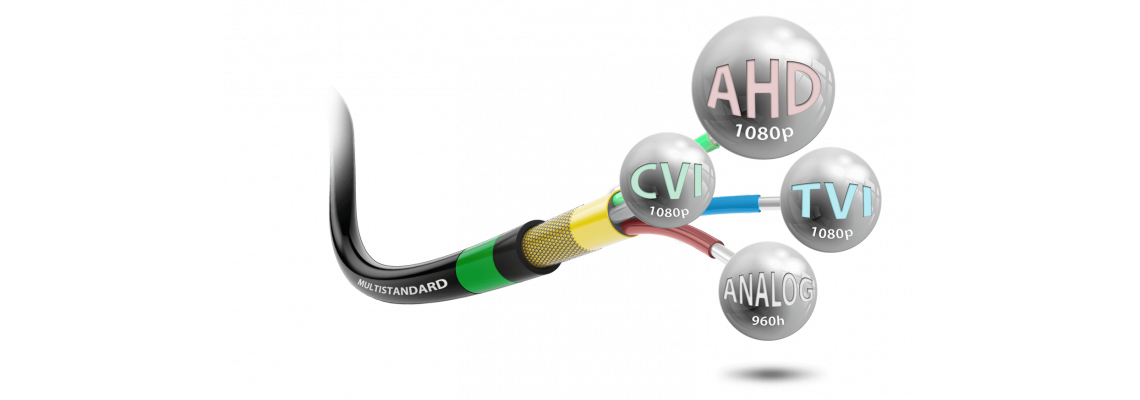Video signāla standarts - AHD, HD-TVI, HD-CVI

AHD, HD-CVI, HD-TVI un CVBS ir video signāla pārraides standarti, jeb tehnoloģijas standarti, kas tiek izmantoti videonovērošanas kameru video signāla pārraidei. Šodien plaši tiek izmantotas hibrīdveida kameras, kas nodrošinā savienojamību ar visiem šiem standartiem.
CVBS videonovērošanā?
CVBS signāla pārraidei videonovērošanā izmanto RG59, CAT5 un CAT5e. Signāls ir ļoti jutīgs uz kabeļa kvalitāti (tā ekranējumu) un uz ārējo faktoru ietekmi - tas var ciest no elektromagnētiskiem traucējumiem, kas rodas, ja kabelis ir tuvu citiem elektriskajiem vai elektromagnētiskajiem avotiem. Kā arī ir lieli signāla zudumi, izmantojot RG59 kabeli maksimālais pārraides attālums ir 100m. Mūsdienās šis attālums var būt lielāks, taču laikā, kad CVBS tika plaši izmantots 100m bija tā galējā robeža.
CVBS ir analogā video signāla veids, kas tika plaši
izmantots līdz mūsdienās pieejamo augstas izšķirtspējas analogo video standartu
kā AHD, HD-CVI, HD-TVI ieviešanai un šodien ir novecojis un vairs netiek plaši
izmantots. CVBS standarta maksimālās tehniskās iespējas no mūsdienu skatupunkta
ir samērā pieticīgas:
Augstākā sastopamā izšķirtspēja bija atkarīga no iekārtas un nodrošināja
720 x 480 pikseļus vai dažreiz 704 x 480 pikseļus, to sauc par D1. Plaši
sastopams bija arī 4CIF standarts. Abi šie standarti nodrošināja attēlu ar malu
attiecībām 4:3.
Parādotiess platekrāna ekrāniem un kamerām attīstījās izšķirtspējas standarts 960H, kura nosaukums norādīja uz horizontālo piksēļu skaitu – 960 x 480 pikseļi. Tas nodrošināja attēlu ar malu attiecībām 16:9.
Šo tehniski ierobežoto iespēju dēļ videonovērošanas nozarē ap 2015. gadu tika izstrādāti jauni tehnoloģiski risinājumi, kas ļautu attīstīties slēgta tipa videonovērošanas sistēmām uz analogā video signāla pārraides bāzes un dotu iespēju pārraidīt augstas izšķirtspējas attēlu digitālā formātā izmantojot, piemēram, vecos koaksiālos kabeļus, kas tika izmantoti analogajām kamerām.
Kas ir AHD, HD-CVI, HD-TVI videonovērošan?
AHD
(Analog High Definition), HD-CVI (High Definition Composite Video Interface) un
HD-TVI (High Definition Transport Video Interface) ir augstas izšķirtspējas
analogo video standarti, kas tika izstrādāti, lai nodrošinātu augstas
kvalitātes video pārraidi pa koaksiālajiem un vītā pāra kabeļiem, piemēram RG59 un CAT5, CAT5e kabeļiem.
Visi šie ir mūsdienās plaši izmantoti videosignāla pārraides standarti, kas dod iespēju pārraidīt video, audio un divvirzienu vadības datu pārraidi, piemēram, PTZ vadāmajām kamerām vai OSD izvēlnei lielā attālumā līdz pat 8MPx un šo standartu teholoģija joprojām turpina atīstīties. Tie savstarpēji ir ļoti līdzīgi savās tehniskājās iespējās, taču katrā no tām ir savas unikālas īpašības un priekšrocības. Viena no kopīgajām priekšrocībām salīdzinot ar paralēli atīstīstījušos tehnoloģiju - IP kamerām visiem šiem standartiem ir tā, ka nav sastopams attēla pārraides aizkavējums, jeb aizture.
Svarīgi atzīmēt, ka visi šie standarti salīdzinot ar analogo video standartu CVBS ir daudz noturīgāki pret elektromagnētiskiem traucējumiem.
HD-CVI ir uzņēmuma Dahua izstrādāta un patentēta tehnoloģija.
HD-TVI ir uzņēmuma Hikvision izstrādāta un patentēta tehnoloģija.
AHD ir nepatentēta, brīvi pieejama tehnoloģija.
| HD-CVI | HD-TVI | AHD | |
| Maksimālā izšķirtspēja un kadru skaits sekundē |
|
|
|
| Audio pārraides iespēja pa veinu kabeli kopā ar video signālu |
|
|
|
Datu pārraides iespējas (PTZ, OSD) |
|
|
|
Maksimālais pārraides attālums pa kabeli |
|
|
|
Pēc mūsu novērojumiem vislabākā attēla kvalitāte bieži tiek iegūta izmantojot signāla veidu, kas ir saistīts ar ražotāju, ja piemēram Dahua ražotam rakstītājam pievieno kameru, kaut vai hibrīdveida, kas dod iespēju izvēlēties kādā standartā pārraidīt video, tad labāks attēls ir izmantojot HD-CVI signāla pārraides standartu.

